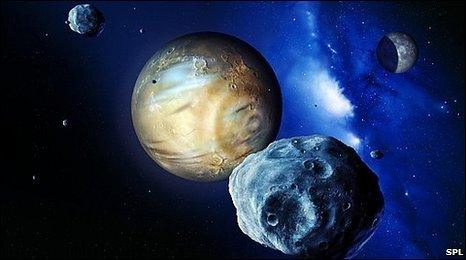Kuiper Belt world measured in star pass
- Published

The Kuiper Belt is home to several dwarf planets, one of which is Pluto
Astronomers say they have observed, for the first time, a distant icy world orbiting beyond Neptune as it passed briefly in front of a bright star.
This "stellar occultation" occurs when a planetary body hides a star as it moves across the sky.
A US-led team of 18 astronomy groups used the occasion to study KBO 55636 from the Kuiper Belt on the outskirts of the Solar System.
They tell the journal Nature that the occultation lasted only 10 seconds.
But this was enough time to determine the object's size and albedo, or reflectivity, the team said.
The Kuiper Belt is a collection of space objects, remnants from the Solar System's formation.
These objects lie beyond the orbit of the Solar System's most remote planet, Neptune.
The Kuiper Belt is similar to the asteroid belt, but instead of being composed of mainly rock and metal, most of its bodies are frozen volatiles - methane, ammonia and water.
Space impact
So far, scientists have detected over a thousand Kuiper Belt Objects (KBOs), but they believe that there may be as many as 70,000 of them.
The lead author of the study, MIT professor of planetary astronomy, James Elliot, told BBC News that the recently observed KBO 55636 probably formed as a result of a space collision about one billion years ago.
He said that a dwarf planet known as Haumea might have been hit by another object, and this impact caused Haumea's icy mantle to break into a dozen smaller pieces, including KBO 55636.
The Kuiper Belt is home to several dwarf planets, one of which is Pluto.
Prof Elliot explained that in order to spot KBO 55636 as it passed in front of a star, he had to get together a team of 42 astronomers from 18 observation stations located in Australia, South Africa, Mexico and the US.
"For several years, we've been accurately measuring the position of the KBO.
"With an accurate orbit, we just projected where it was going to be in the sky and looked for stars that it might occult."
The scientist explained that it was hard to predict exactly where the KBO would pass.
In order "to be on the safe side", his team used a number of observation stations along a 5,900km stretch of the Earth's surface that corresponded to the predicted shadow path of the space body.
"It was our way of hedging our bets," he said.
Out of the 18 telescopes aimed at the sky, only two stations, both in Hawaii, managed to detect the 10-second-long stellar occultation.
High albedo
The researchers then measured the exact amount of time that the star was blocked from view and the velocity of the KBO's shadow moving across Hawaii.
Using this data, the team determined the object's size - about 300km in diameter - and its albedo, or ability to reflect light.
The scientists thought that the surface of KBO 55636 would be rather dull, unable to reflect much light due to space weathering, dust accumulation and bombardment by cosmic rays.
But the results were unexpected, said Prof Elliot.
"We found out that this object is much smaller than we thought before and that it is very reflective - it reflects most of the light that hits the surface."
He explained that the surface is probably made of ice - very much like the surface of Pluto.
But bigger objects, such as Pluto or Saturn's moon Enceladus, are able to brighten their surfaces with a fresh supply of ice from processes such as cryovolcanism which sees ice - not lava - spew from the interior of the objects.
This explanation did not really apply to the KBO due to its tiny size and the time it had spent floating in space, said the professor.
"I am not sure [why the albedo is so high]. Maybe because water-ice surfaces are more robust and don't get darkened by cosmic ray impacts and other things that darken other surfaces."